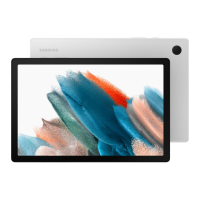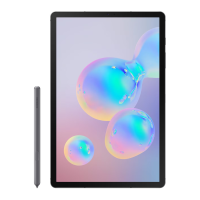
Do you have a question about the Samsung GALAXY TAB and is the answer not in the manual?
| Processor family | - |
|---|---|
| Processor frequency | 1 GHz |
| Card reader integrated | Yes |
| Internal storage capacity | - GB |
| Display diagonal | 7 \ |
| Display resolution | 1024 x 600 pixels |
| Display number of colors | 16.78 million colors |
| Graphics card | PowerVR SGX540 |
| Bluetooth version | 3.0+HS |
| Mobile network generation | 3G |
| Microphone in | No |
| USB 2.0 ports quantity | 1 |
| Ethernet LAN (RJ-45) ports | 0 |
| Dimensions (WxDxH) | 121 x 11.98 x 190 mm |
| Battery capacity | 4000 mAh |
| Operating system installed | Android |
| Form factor | Slate |
| Product color | Black, White |
| Audio formats supported | AAC, MP3, OGG, WAV, WMA |
| Weight | 380 g |
|---|
Details warranty exclusions and liability limitations.
Information on obtaining source code under open source licenses.
Explains manual structure, conventions, and notes.
Instructions on how to charge the device battery.
Steps to power the device on and off.
Guides through initial device setup, including language and Wi-Fi.
Explains device locking mechanisms and security options.
Basic troubleshooting steps for device errors like freezing.
Lists key hardware and software features of the device.
Explains the Home screen as the device's starting point.
How to navigate the device using command buttons and touch screen.
How to access and use Quick Settings for common device controls.
Explains what widgets are and how they appear on the Home screen.
How to add and remove app shortcuts from the Home screen.
Using the virtual QWERTY keyboard for text entry.
Guide to using XT9 predictive text features.
How to cut, copy, and paste text within and across apps.
How to use voice input for text entry.
Explanation of device synchronization with various accounts.
Step-by-step guide for creating new contacts.
How to update existing contact information.
How to send and receive email using Gmail.
Step-by-step guide for composing and sending Gmail messages.
Using the Email app to manage multiple email accounts.
Steps to configure email accounts, including server settings.
Using Google Talk for instant messaging and chat.
Accessing the internet using the HTML Browser.
How to navigate pages and reposition elements on screen.
How to bookmark websites for quick access.
Using Google Maps to find locations and get directions.
Using Google Navigation to find destinations and directions.
Searching the internet and device using Google search.
Viewing and uploading YouTube videos.
Overview of the Music app for playing music and audio files.
How to find music by artist, album, song, or playlist.
How to listen to music using device speakers or Bluetooth.
Steps to create a new music playlist.
Accessing, buying, and downloading music tracks via Music Hub.
Using the built-in camera to take photos and record videos.
Step-by-step guide for taking photos with the device camera.
Detailed camera settings like exposure, timer, resolution, and effects.
Using the Video Player to view and manage videos.
Using Gallery to view, capture, and manage photos and videos.
Using the Photo Editor for basic image editing functions.
Overview of Wi-Fi technology and its uses.
Steps to turn the device's Wi-Fi service on or off.
How to scan for and connect to Wi-Fi networks.
Using Bluetooth settings to manage connections and device visibility.
How to search for and pair with Bluetooth devices.
How to uninstall applications from the device.
Setting up and managing Virtual Private Networks (VPNs).
Using GPS for navigation and location-based searches.
Setting alarms for reminders or wake-up times.
Managing downloaded files, apps, and items.
Accessing downloadable applications and games from Google Play Store.
Searching the internet and device using Google search.
How to access the device's main Settings menu.
Information about Wi-Fi technology and its features.
Steps to turn the device's Wi-Fi service on or off.
Using Bluetooth settings to manage connections and device visibility.
How to search for and pair with Bluetooth devices.
Viewing device memory, mounting, unmounting, or formatting SD cards.
How to format an SD card using the device or computer.
Viewing battery power usage by device activities and applications.
Setting up and managing accounts like Google and email.
Enabling location services for location-based features.
Security related settings.
Resetting the device to factory defaults, erasing all data.
Input related settings.
Options for Samsung keyboard like input language and predictive text.
Information on RF exposure from wireless phones and GALAXY.
Steps to minimize RF exposure using accessories.
FCC SAR limits and compliance information for mobile devices.
Responsible driving practices and avoiding distractions.
Information on safe battery usage and replacement.
Suggestions for maintaining the device and fulfilling warranty obligations.
Recommendations for safe listening practices with portable audio devices.
Maintaining separation between the device and medical implants like pacemakers.
Details what is covered and for how long under the limited warranty.
Lists conditions and damages not covered by the limited warranty.
SAMSUNG's obligations for repair, replacement, or refund during warranty.
Steps for obtaining warranty service, including returning the product.
Limits on SAMSUNG's liability, including exclusion of damages.
Outlines the process for resolving disputes through binding arbitration.
Samsung's license grant for software use.
Restrictions on end-user rights regarding software use and modification.
Limits on SAMSUNG's liability for damages related to third-party applications.
Governing law for the EULA, typically Texas law.











